
Rusty Blackbird: the mysterious decline of a common boreal bird
This article was made possible thanks to support from the Environmental Awareness Fund. Engage and educate yourself in this 10-part blog series, about Yukon Biodiversity.
Pam Sinclair’s contribution was supported by the Canadian Wildlife Service of Environment and Climate Change Canada
15 minute Read –
One cold grey day in late October, we went looking for American Dippers in a salmon spawning stream in southwestern Yukon. It’s always fascinating to see those strange little songbirds walk right in to the surging water and disappear as they search for food in the rocky stream bed, and then pop back out on shore. Arriving at the creek, we saw a couple of birds right away on a tiny rocky island in the rushing water. But peering through fogging binoculars in the dim grey light, it took a moment for the image to take shape and for us to realize that these were not dippers, but Rusty Blackbirds! Rusty Blackbirds nest in forest wetlands throughout the Yukon but most are well on their way to wintering grounds in the Mississippi River area by late October, and it’s unusual at any time to see them in fast-moving water.
American Dipper Klukshu YT taken March 2018
Sure enough, there were also two dippers working their way along the stream, and it was striking how similar the two species looked and behaved. The blackbirds were plunging only their heads into the water, while the dippers didn’t hesitate to go under entirely; but both appeared to be feasting on salmon eggs. This was typical for dippers but I’d never heard of blackbirds taking advantage of this food source. Being opportunistic is not unknown for Rusty Blackbirds; in winter, they eat pecans but can’t crush the shells on their own. Instead, they either pick up the pecan pieces that larger grackles have dropped or hang around areas where roads or driveways are close enough to pecan trees for vehicles to have crushed some fallen nuts! They’re also known to gather in large numbers to eat compost and can even been found snacking on the garbage piles at the Whitehorse landfill. It made me wonder: if Rusty Blackbirds can be so opportunistic, why has their population declined so dramatically?
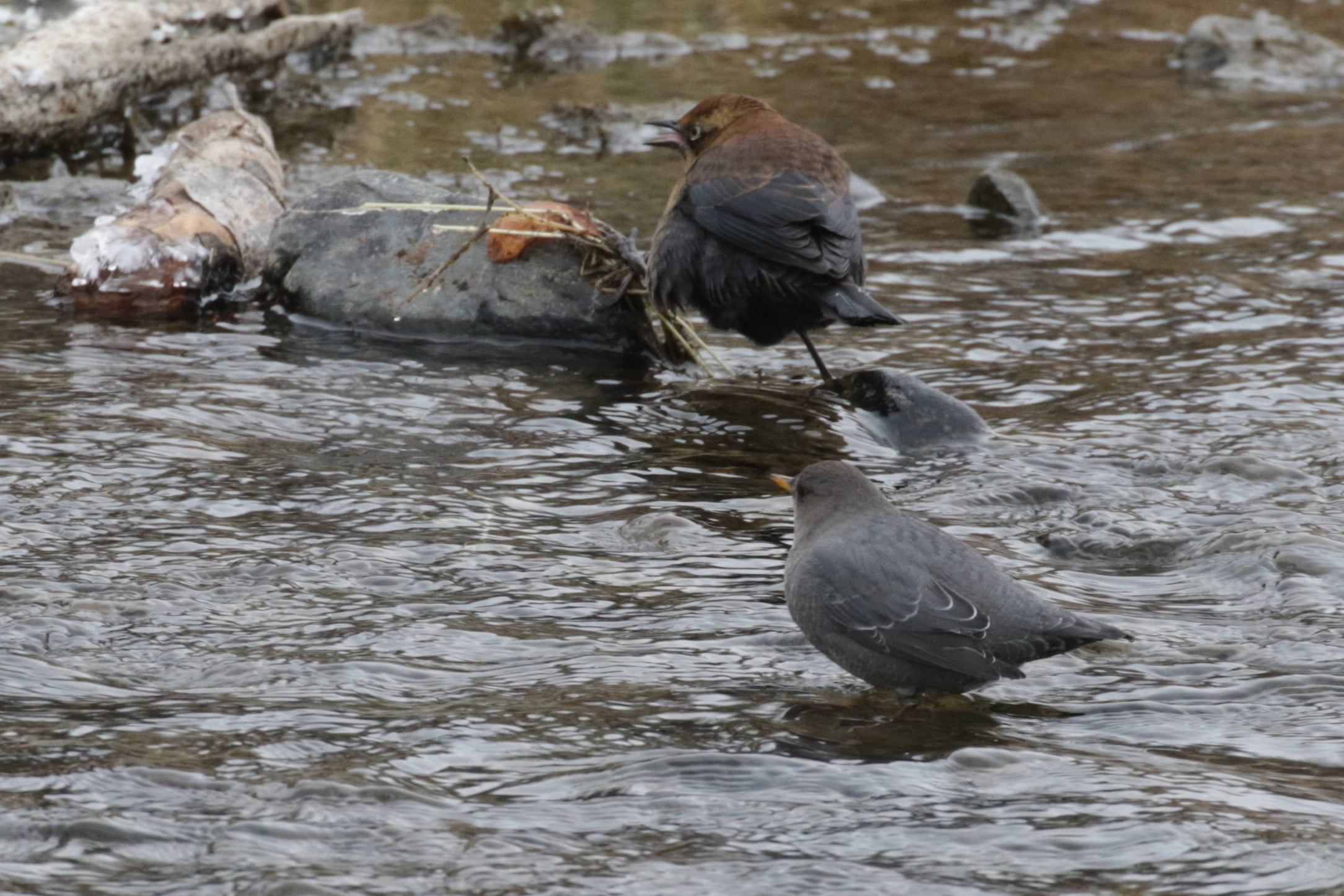
Rusty Blackbird and American Dipper Southern Yukon taken Oct 2020.
A quick overview of what we do know: “Rusty Blackbird” is a title very well suited to these birds. Male Rusty Blackbirds are completely black during the spring breeding season but during the winter, they have “rust” colored plumage blending into the black. The females also have rust-coloured edges on their grey-brown plumage, hence the name! These are migratory birds that are only found in North America. As stated in Audubon website: “Birders might say that this blackbird is rusty because it spends so much time in the water.” And that is due to the fact these birds prefer a damp environment. These boreal forest residents enjoy forest wetlands including slow moving streams, swamps, marshes, beaver ponds, and the edges of pastures. In the Yukon, you can look for them in these forest wetlands in spring and early summer, and along the edges of rivers and lakes in the fall.
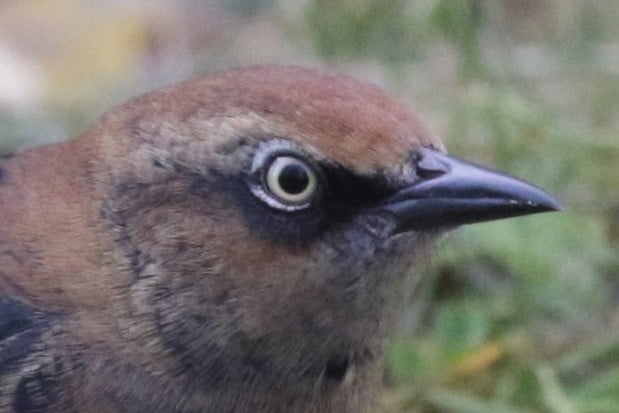
Male Rusty Blackbird first year taken Whitehorse YT Sept 2020.
Until recently, the Rusty Blackbird was simply part of the fabric of the boreal forest landscape, common across the region from Alaska to Labrador. Few bird surveys or studies were conducted within its inaccessible, buggy breeding range. Blackbirds in general have long been considered agricultural pests because they eat grain and corn, and for this reason, when Canada and the U.S. signed a treaty to protect migratory birds more than a century ago, blackbirds were left out of the agreement. Nobody paid much attention to the Rusty Blackbird. Then in 1999, well-known U.S. bird biologists Russ Greenberg and Sam Droege noticed that these birds were disappearing from southern U.S. wintering grounds, and published a paper showing that numbers of Rusty Blackbirds had been declining for decades. The Rusty Blackbird soon gained the dubious distinction of having the steepest population decline of any North American songbird: 85 to 95% of the birds had disappeared in 40 years. Nobody knew why. Nobody knew much about this species at all.
Why was the Rusty Blackbird in trouble? It spends the summer in the vast and relatively undisturbed boreal region. In winter, it resides in “bottomland” habitats like oak forests with puddles and ponds in the southeastern United States. There has been a lot of deforestation in that area, which often leads to complication and declines in animal populations, and probably contributed to the historical decline of Rusty Blackbird. But the slower recent pace of deforestation is not enough to explain the decline in Rusty Blackbird numbers in the last few decades. Bird biologists and conservationists were concerned. If this common boreal bird is declining, something must be seriously amiss in its environment. But what? In order to figure out what was going on, and ultimately to figure out how to stop the decline of this bird, biologists and conservationists from the U.S. and Canada formed the International Rusty Blackbird Working Group and made a research plan.
Over the last two decades, there have been incredible advances in the technologies used to track the movement of birds. This has helped both the small group of scientists studying the decline of Rusty Blackbirds and the study of migratory birds as a whole! In the case of Rusty Blackbirds, we have learned that their annual cycle is more complex than simply migrating back and forth between nesting and wintering grounds. For example, a young Rusty Blackbird which hatches in the Whitehorse area in June, will have left the nest and grown its full set of feathers by July. But unlike many local songbirds that start heading south in early August, the young Rusty Blackbird will then start growing a whole new set of feathers, and settle in to a good feeding area for a month or two, before heading south by late September or early October. From there it will leave to spend around a month in the Canadian Prairies or the Dakotas. From there, it’s on to wintering grounds in the Mississippi valley, heading north in spring but stopping for a month or so in March/April at another good feeding area before returning to the nesting grounds.

Adult male Rusty Blackbird WhitehorseYT Sept 2020.
Instead of following the nesting-migrating-wintering-migrating pattern that many migratory birds follow, the Rusty Blackbird’s year involves major stopovers at two or three additional locations. Does this make it more vulnerable, because it relies on good, safe food sources at about five major locations each year? Or does it make it more adaptable, because if one location does not meet its needs, it can move on to the next?
Typically for any ecological question, the answers are more complicated than expected. When the Rusty Blackbird working group set out to determine what was causing the decline, several possibilities were explored. Rusty Blackbirds are susceptible to high levels of mercury toxicity, especially in eastern North America where pollutants from coal-fired electrical generating stations cause acid deposition in wetlands, which releases naturally-occurring mercury. Rusty Blackbirds are high in the food chain because they consume aquatic insects like dragonfly larvae, which eat smaller invertebrates. This causes bioaccumulation resulting in high levels of mercury in these birds. Bioaccumulation is the accumulation over time of a substance and especially a contaminant (such as a pesticide or heavy metal) in a living organism from all sources including water, air, and diet. Animals higher in the food chain, such as the Rusty Blackbird, can acquire a larger load of contaminants as they will consume other creatures that have also consumed contaminants.
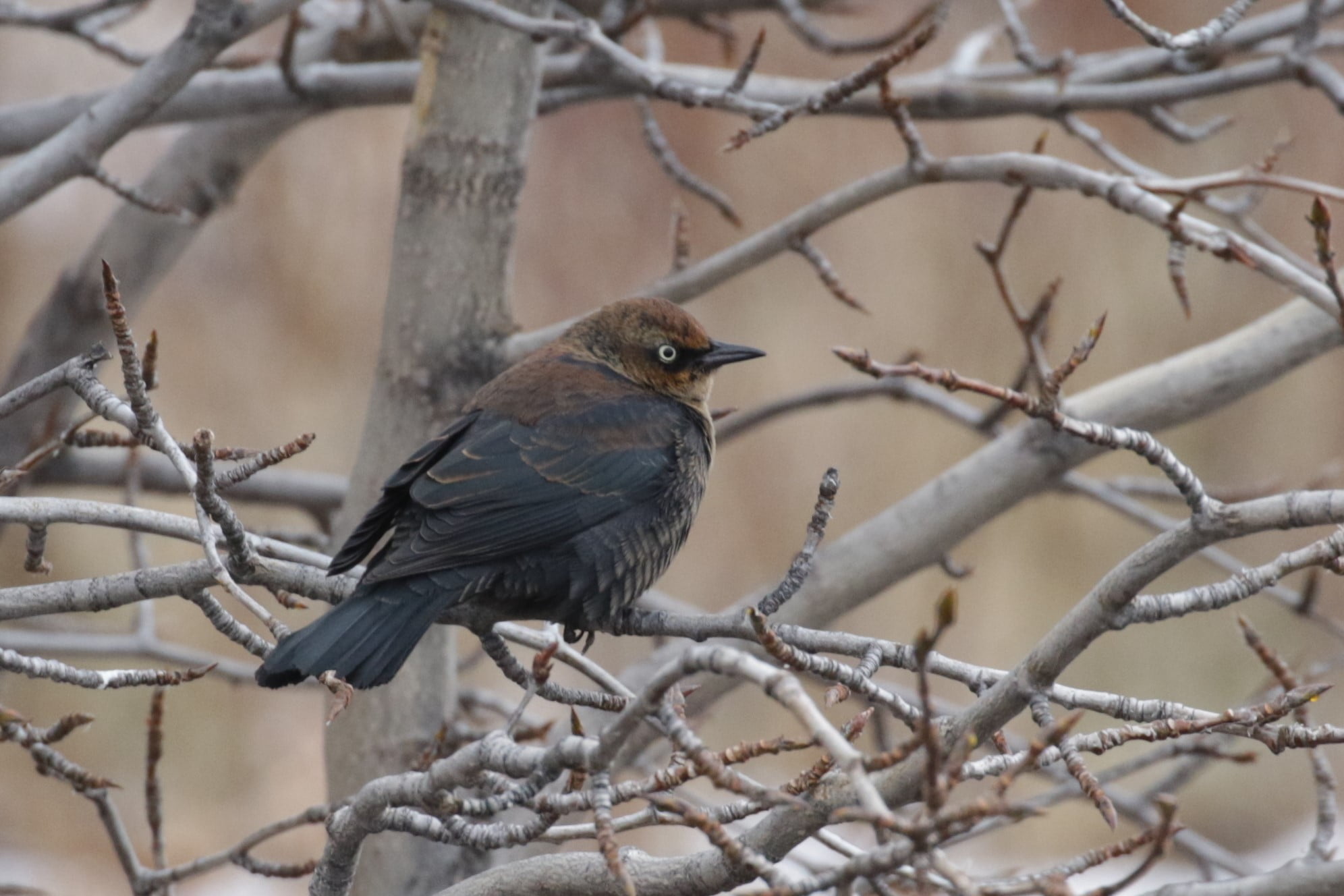
Rusty Blackbird Southern Yukon taken Oct 2020.
But Rusty Blackbirds are also declining in areas with little acid deposition. On the wintering grounds, other blackbird species (Red-winged Blackbirds and Common Grackles, along with starlings and cowbirds) have been legally killed by spraying the birds as they roost in flocks at night, or by putting out poisoned bait to prevent them from feeding on agricultural crops. Rusty Blackbirds sometimes share roost sites with these species and may be inadvertently killed as well. There is little information on the species composition of affected flocks, so it is unknown if this is a major factor in the decline of Rusty Blackbirds. Habitat loss in the boreal region is occurring, from conversion to agriculture, oil sands development, flooding for hydro dams, and forest harvest. This is not occurring at a pace that would fully account for the decline but it is likely a contributing factor. Pesticide runoff, and habitat loss due to agricultural intensification and urbanization, may be affecting Rusty Blackbirds on their stopover sites on the Great Plains. In short, no single factor explains the decline. Possibly, all of these factors are contributing.
Rusty Blackbirds are found throughout the Yukon, and biologists at the Canadian Wildlife Service (CWS) in Whitehorse were keen to help investigate this declining local species. When research began, some very basic knowledge of the species was lacking, such as how to distinguish first-year birds from adults based on their plumage. This is straightforward for most songbirds, but it turned out to be difficult in this species. When investigating rates of reproduction and survival in order to determine the causes of decline, it is crucial to know the ages of the birds, because survival is usually much lower for inexperienced first-year birds. It was also discovered that Rusty Blackbirds are “neophobic”, or fearful of new things in their environment, compared to other blackbirds such as Red-winged Blackbird. This makes it difficult to capture Rusty Blackbirds for study.

Rusty Blackbird male Whitehorse YT taken June 2019
After trying several techniques, mist nets being particularly successful, CWS biologists were able to capture good numbers of Rusty Blackbirds in Whitehorse. These successful captures provided a unique opportunity to figure out how to distinguish first-year from older birds. In September, when Rusty Blackbirds are common around Whitehorse, birds in the hand can be aged with certainty by examining the growing area of ossification (hardening) of their skull, which appears as white dots which can be viewed through the bird’s thin translucent skin by a skilled observer, with no harm to the bird. Once the birds arrive at the southern bird banding stations in the Canadian prairies and the U.S., the young birds’ skulls have ossified and are identical to those of adults. Taking advantage of this unique opportunity, we were able to compare first-year birds with older birds and determine the subtle differences in colouration. Both male and female Rusty Blackbirds have white around their eyes in their first year of life that isn’t present in adult birds. The amount of this white “eye-liner” varies from bird to bird but if it’s present, it’s a first-year bird. The results were provided to researchers further south, so that they could reliably determine the age of each bird in their studies. While conducting this work in Whitehorse, we were also able to confirm that Rusty Blackbirds grow two complete sets of feathers in their first four months of life, which is unusual among bird species, and that they stay in the boreal region for many weeks in order to grow all of those feathers before heading south.
It can take a lot of effort to chart the life and migratory cycles of even a single bird species. Even after we gain a better understanding of the factors affecting their lives, discovering the cause or causes behind a population decline can be very difficult as is the case of the Rusty Blackbird. However, there are still some conservation actions that would very likely help the Rusty Blackbird, the natural environment in general, and human health: reduced use of harmful pesticides such as neonicotinoids, maintaining natural wetland habitats within intensive farmland, and reducing the use of coal to generate electricity. Migratory birds, even those that stay within North America, make us realize our interdependency with other nations and our shared environment.
For more information on the Rusty Blackbird, go to www.rustyblackbird.org
Written by Pam Sinclair (Canadian Wildlife Service) in conjunction with Joelle Ingram.
Where not otherwise noted photo credit: Pam Sinclair
References:
Edmonds, S. T., Evers, D. C. , Cristol, D. A., Mettke-Hofmann, C. , Powell, L. L., McGann, A. J., Armiger J. W., Lane, O. P., Tessler, D. F., Newell, P., Heyden, K. and O’Driscoll, N. J. (2010). Geographic and seasonal variation in mercury exposure of the declining Rusty Blackbird. Condor, 112(4): 789–799.
Greenberg, R. and Droege, S. (1999). On the decline of the Rusty Blackbird and the use of ornithological literature to document long-term population trends. Conservation Biology, 13(3): 553–559.
Greenberg, R., Demarest, D. W., Matsuoka, S. M., Mettke-Hofmann, C., Evers, D., Hamel, P. B., Luscier, J., Powell, L.L., Shaw, D., Avery, M. L., Hobson, K. A., Blancher, P. J. and Niven, D. K. (2011). Understanding Declines in Rusty Blackbirds. Studies in Avian Biology, 41: 107–126.
Mettke-Hofmann, C., Sinclair, P. H., Hamel, P. B. and Greenberg, R. (2010). Implications of prebasic and a previously undescribed prealternate molt for aging Rusty Blackbirds. Condor, 112(4): 854–861.
Recording of a presentation on Yukon Rusty Blackbird research:
Sinclair, P. 2020. Molt ecology of Rusty Blackbird in southern Yukon. International Rusty Blackbird Working Group Symposium, The Wildlife Society 27th Annual Conference, October 2020.

Joelle Ingram
Human of Many Talents
Joelle is a former archaeologist, former wildlife interpreter, and a full-time random fact enthusiast. She received her master’s degree in anthropology from McMaster University. One of the four people who read her thesis gave it the glowing review “It’s a paper that would appeal to very specific group of people,” which is probably why only four people have read it. Her favourite land mammal is a muskox, her favourite aquatic mammal is a narwhal. She thinks it’s important that you know that.

Pam Sinclair
Bird Conservation Biologist
Pam Sinclair is a Bird Conservation Biologist with the Canadian Wildlife Service of Environment and Climate Change Canada, in Whitehorse

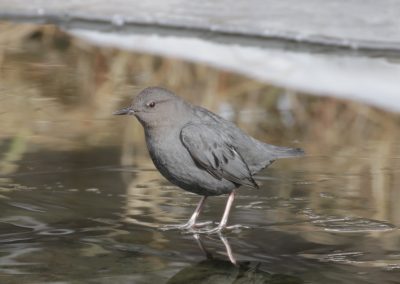
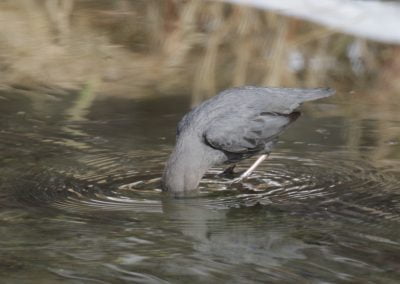
Thank you Joelle, I loved it!
What an informative article! Having recently moved to Whitehorse I will train my eyes to find the Rusty Blackbird! A. Sims
Just a thought ? I have noticed the Rusty Blackbirds feeding heavily on the chokecherry trees here in Dawson City each each fall about now ,Sept 25th. Do you think the cyanide might be affecting them ? Perhaps chock cherry trees have been planted in Whitehorse as well and the birds are getting a double dose or maybe berry’s are harmless and the seed passes right through them. Not a berry is left when they pass through. One thing for sure, They sure like them and the berry’s have just been added to the landscape in the past 25 years.
Thanks for reading the article & the comment. Might I suggest reaching out to Pam directly to ask this question, as she will be best to answer it but will not get your comment notification directly.
Thanks again!
In winter we frequently watched a flock of 30 or so Rusty Blackbirds foraging on an old RR bed that went across a marsh on the Patuxent River, Maryland. The RR bed was adjacent to a swamp, then out to freshwater tidal wetland. Grackles in huge flocks swept through the forests here gathering oak acorns. The grackles often stopped in trees along this RR bed to finish devouring their acorns. In the process, the grackles dropped bits of acorn meat on the RR bed. The Rusties then walked beneath on the ground, eating the dropped acorn bits. Always found this interesting! I think Brook Meanley, USFWS, wrote a bit about this behavior.
Thanks for taking the time to connect with us via our blog and share a bit of your wildlife viewing experiences.